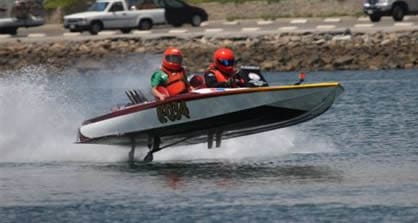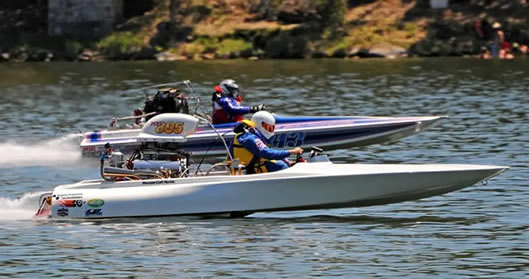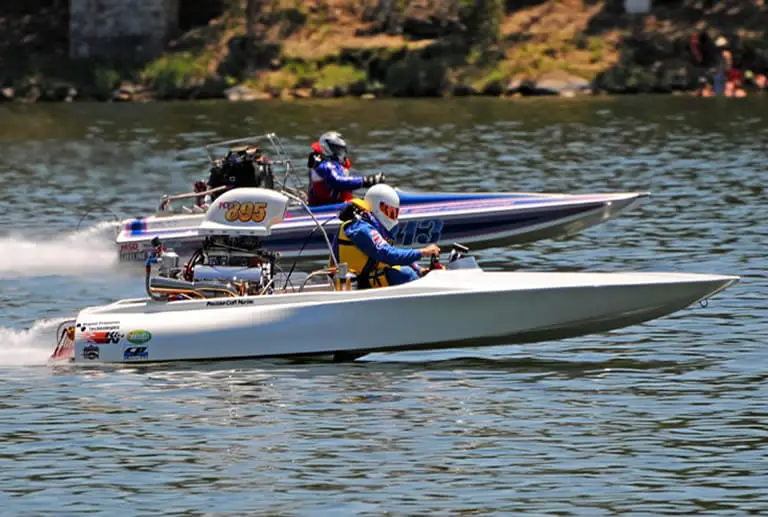The world of flat bottom speed boat racing is filled with thrills and water speeds that match Formula One track racing. The sport keeps growing in popularity as the fun-filled action-packed races see new boat innovations and higher speeds each year.
Contents
What Exactly Is Flat Bottom Speed Boat Racing?
Flat bottom speed boat racing involves flat-bottomed hulled boats competing against each other or against the clock.
With a flat bottom and shallow draft a flat bottom boat can quickly get on plane and thus encounter less friction thus reaching higher speeds.
There are a variety of flat bottom speed boat races divided into different classes.

There are flat bottom drag boat, powerboat, dingy, Jet boat, Track boat, Swamp boat and airboat races.
The races take place in a variety of different environments from rivers to man-made courses.
Classes Of Flat Bottom Speed Boat Races
Flat bottom speed boat racing is divided into different classes with each race having its own set of rules.
The races are run on different courses, some on rivers and lakes while others run on very tricky water canals or man-made courses.
These races have different kinds of courses with different boat and speed categories.
Some boats have only one driver, while others feature both a driver and a passenger who helps counterbalance the boat while maneuvering at high speeds.
Dinghy boat racing
Dinghy boat races are known for their wild nature. They include single or two racer dinghy boats.
The boats are kitted-out with an outboard engine. There are different levels of horsepower for different race categories.
They range from 15 HP – 30 HP. Many of the dinghies resemble Jon boats in their design.
Dinghy racers must navigate through treacherous paths at very high speeds with no safety straps or restraints to protect them.
This can be dangerous as racers often reach high speeds of up to 50 mph, sometimes navigating mere inches away from boat-shattering and life-threatening obstacles.
To race at such speeds on an open boat requires nerves of steel especially if the only safety features you have are a helmet and a PFD (personal flotation device).
Flat bottom drag boat racing
Similar to a drag racing on land, this waterborne race features two riders in a boat that race over a given distance, usually a quarter of a mile or 1000 feet.
The race “track” is a straightway with no obstacles.
The one who crosses the finish line first is the winner and that usually means the person with the fastest boat (unlike obstacle races which, arguably, require more skill).
Flat bottom drag boats come in 3 different categories.
Namely,
- Hydroplane drag boats.
- Flat bottom drag boats.
- Jet drag boats.
Although similar to drag races on land there are differences. Compared to a land drag race, where racers start from a dead stop, the racers do not start from a standing position.
They have a rolling start and the rule is not to pass the start point before you get the green light as this leads to automatic disqualification.
This rolling start is offered because it is difficult for racers to get their boats to launch at speed from a standing position. So this rolling start was included to ensure racers have a smooth start and can build-up their speed quickly.
The speeds that drag boats can reach are astounding. Flat bottom boat drag boats can reach speeds of 50 MPH.
Hydroplane flat bottom drag boats can reach speeds of 270 MPH.
Spectators are blessed with the sight of boats almost taking-off and flying as they accelerate to high speeds extremely quickly and bounce off the water.
As you can imagine this type of flat bottom speed boat racing can be very dangerous.
Hydroplane racing is the Formula One of the waterways.
You can read more about drag boat racing here and learn more about drag boats and their costs here.
Jet boat river racing
Jet boat river racing is a race involving boats crewed by 2 people.
The boats are competing against time rather than directly against one and other in a head-to-head race.
The racers pass through a twisting course on shallow waters with water levels up to, or less than, a meter deep.
The winner of the race is the pair of racers who navigate through the course in the shortest time.
The course is designed to awe spectators as the race itself is usually very short lasting just under a minute each.
Each race will have 20 to 30 directional changes incorporated into the course to test the crew’s skill.
The races feature a qualifying race where racers get a starting berth depending on their qualifying times.
Racers who qualify with the longest time go last.
The winning process is determined through a series of eliminations moving from the last 16, to the last 8 then the last 5, before the final which involves the 3 boats with the fastest times.
This type of flat bottom boat racing is fast and exhilarating for both the boat crew and the spectators.
Track boat racing
Track boat racing is also called Jet sprint racing.
These races are quite thrilling to the spectators and racers as the boats race against time in a track full of corners and straight paths.
There are individual races to determine the fastest sprinter on an often muddy course.
Boats do not compete against each other head-to-head.
The thrill of seeing boats turn and miss turns at very high speeds is exhilarating to watch.
This is similar to jet river racing except the boats race through an obstacle course.
Jet sprint boats are fast and can burst into speed quickly with the power of 500 HP engine.
Fan boat/Airboat racing
Fan boats are also known as airboats because the big propeller in the fan at the back of the boat propels the boat forward via air.
Although airboat is the more common term used for a fan boat, these types of vessels are also called swamp boats because they are very popular in swamp lands.
You can read more about Airboats and their history here.
Airboat racing is a popular sport where racers are categorized according to the engines they use or their fuel type.
The categories will also include airboats powered by aircraft engines, those powered by automotive engines and those fueled by regular gas or diesel.
Although not as fast a drag racers these flat-bottomed boats can reach top speeds of up to 130 mph on the straight.
Airboat racing requires a great deal of skill and expertise and is often a controlled racing event that takes place in a controlled environment due to its dangerous nature.
Airboat racing is such an expansive subject that we covered in its own article which you can read here.
American powerboat racing
These races are sanctioned under the American Power Boat Association (APBA) and have different classes for racers to participate in.
There are a variety of races conducted by APBA annually including:
- Outboard performance craft.
- Stock outboard.
- Outboard drag.
- Offshore.
To create a level playing field, offshore racing is closely monitored and strict rules apply to boat weights and engines.
Winners have their engines broken down and scrutinized to ensure they comply with the strict regulations.
Swamp boat racing & Jon boat racing
These are high paced individual races on river swamps.
They are often raced in semi- v Jon boats.
A mod-v jon boat has a flat bottom with a bow that has slight curve upward. This makes cutting through choppy water easier.
There is also Jon boat racing along rivers and creeks.
The courses for swamp boat racing often have very treacherous obstacles and can be dangerous to compete in.
The idea is to navigate the obstacle-laden swamp at faster speeds than your competitors while avoiding the obstacles in your path as you race to the finish line.
The narrow passages test the navigational skills of racers through shallow muddy obstacle-ridden waters.
This makes the race very exciting to participate in and watch (if you are lucky enough to see one).
Winners set the best time on the course.
This is more of a participant sport than a spectator sport as the races happen in existing swamp lands that have little no spectator access.
Watch a video showing Jon boat racing in the Dingy Derby below.
Where Do They Race Flat Bottom Boats?
Flat bottom boat racing is popular in several countries with its biggest support coming from the USA, New Zealand and Australia.
The popularity of the sport may be growing but it is still not as famous as other types of boat racing.
Nor is it as famous, or popular, as high speed land-based racing.
At the moment many flat bottom racers have difficulty attracting sponsors which is slowing down the growth of the sport.

However, flat bottom boat racing is gaining momentum and racers nowadays can even contend for a world championship title.
At the moment the championship races are hosted between New Zealand, Australia and the United States of America with the hope of adding more countries as the sport increases in popularity.
Flat bottom boat races are split into different categories that are based on the boat type and engine size.
These races offer different challenges for racers and different thrills for spectators.

